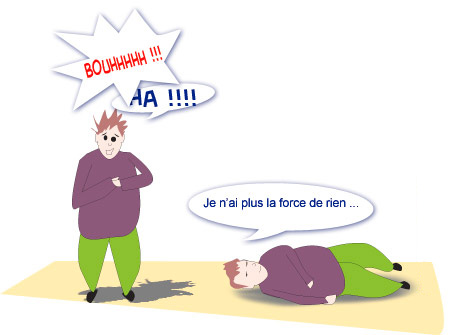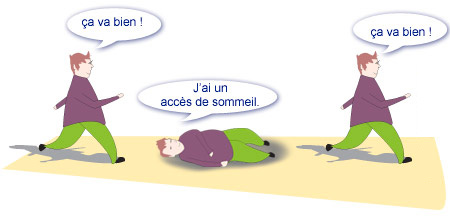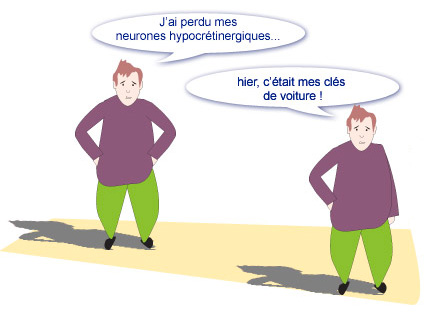Definition / Frequency - Clinical signs - Cause of the disease - Assessment to be carried out - Variant without cataplexy - Treatment of excessive daytime sleepiness - Treatment of cataplexy
Definition / Frequency
Narcolepsy is a cause of excessive daytime sleepiness. It is most often associated with another symptom called cataplexy.
Narcolepsy is a rare condition, affecting only 0.026% of the general population.
The age of onset of narcolepsy is variable and ranges from early childhood to late adulthood. However, the majority of patients report the onset of their symptoms during adolescence.
The familial nature of narcolepsy has been known since the original description of the disease but accounts for less than 10 % of narcolepsy patients.
Clinical signs
Narcolepsy is characterised by two major symptoms:
- excessive daytime sleepiness: this is the most disabling symptom, characterised by recurrent bouts of uncontrollable sleep (which the patient can neither prevent nor control), and always restoring normal wakefulness.
- Cataplexy is characterised by brief and sudden (usually partial) loss of muscle tone, without alteration of consciousness, in connection with strong emotions. This symptom is very heterogeneous in its clinical presentation, both in terms of intensity and frequency. It allows the condition to be identified almost unequivocally.
The other symptoms of narcolepsy, hypnagogic hallucinations, sleep paralysis and poor sleep quality are considered incidental as they are inconsistent and sometimes found in the general population.


Cause of the disease

Narcolepsy is caused by the loss of hypocretinergic neurons, located in the laterodorsal part of the hypothalamus.
Hypocretin-1 levels in cerebrospinal fluid (CSF) are collapsed in narcoleptics and post-mortem anatomical pathology of the brain reports a near complete disappearance of these hypocretinergic neurons.
A neurodegenerative mechanism of autoimmune origin is the most likely hypothesis for this neuronal loss.
However, one case of narcolepsy has been reported in relation to a mutation in the gene coding for preprohypocretin (precursor of hypocretins 1 and 2), as in the canine narcolepsy model (mutation in the gene coding for hypocretin receptor 2).
Assessment to be carried out
The diagnosis of this condition is clinical:
- Polysomnographic recording is necessary, as are iterative daytime sleep latency tests that confirm the diagnosis (mean sleep latency less than 8 minutes and at least 2 REM sleep episodes out of 5 tests performed).
- Analysis of the HLA (Human Leukocyte Antigen) class II system: serological HLA typing DR2-DQ1 and more precisely oligonucleotide HLA DRB1*1501-DQB1*0602. It will confirm the diagnosis, since these genetic characteristics are found in more than 92% of cases in narcoleptics and only in 20% of the general population.
- Rarely, a cerebrospinal fluid analysis (by lumbar puncture) in order to measure hypocretin-1 may be considered in case of diagnostic doubt.
Variant without cataplexy
There is a variant to this disease: narcolepsy without cataplexy.
This condition has the same clinical (except for cataplexy) and polysomnographic diagnostic criteria; however, the association with HLA DQB1*0602 is less strong and the decrease in hypocretin-1 in the CSF is relatively rare.
This condition may in fact be pathophysiologically distinct from narcolepsy with cataplexy. A continuum between these different hypersomnias is however likely, as all intermediate forms may exist.
Treatment of excessive daytime sleepiness
The first-line treatment is modafinil. The mode of action of this drug is not fully understood but a dopaminergic mechanism is highly probable.
If this fails, methylphenidate may be useful.
Finally, mazindol as well as some other amphetamine derivatives can be used in some cases.
There is also sodium oxybate which seems to be of interest for the treatment of drowsiness in these patients.
Treatment of cataplexy
The treatment of cataplexy is pharmacological.
Antidepressants have been used extensively, initially the tricyclics (clomipramine) and MAOIs (selegiline), which are particularly effective without mood enhancement.
Currently, serotonin reuptake inhibitors (fluoxetine) or norepinephrine reuptake inhibitors (reboxetine) or both (e.g. venlafaxine) are more commonly prescribed as they are equally effective and have fewer side effects.
Sodium oxybate also seems to be very interesting for the treatment of cataplexy.
In case of persistent symptoms, mazindol (an amphetamine derivative) may be useful, being effective on daytime sleepiness and cataplexy.
Immunomodulatory treatments, especially in the early phase, as well as hypocretin or hypocretinergic agonist substances are likely to be the treatments of the future.


